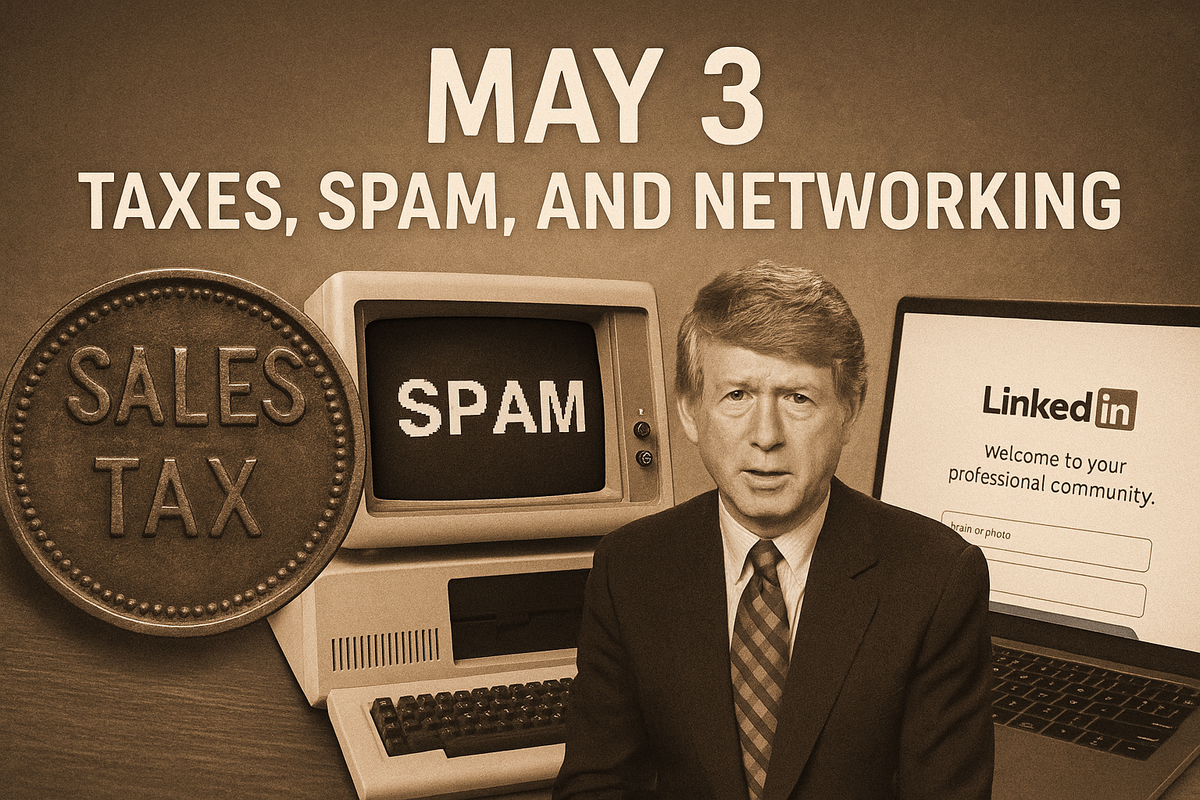
Understanding business history reveals patterns, exposes opportunities, and builds foresight—helping small businesses innovate, adapt, and grow in a fast-changing world. Each milestone reminds us how yesterday’s shifts shape today’s success.
By Dr. Ethan Fairbanks | WBN News – History Edition | May 3, 2025
Taxes, spam, storytelling, networking, and unemployment—May 3 shows how regulation, reach, and relationships define the evolution of business.
Source: West Virginia Archives | Date: May 3, 1921
West Virginia Enacts First State Sales Tax in the U.S.
West Virginia introduced America’s first state sales tax on this date, creating a new revenue model for state governments. Other states quickly followed, setting a nationwide precedent for consumer taxation.
Why It Matters:
Small businesses must understand how taxation affects pricing, margins, and compliance. Sales tax remains a vital, often complicated, part of running a retail or service operation, especially in today’s online economy.
Source: Computer History Museum | Date: May 3, 1978
First Spam Email Sent on ARPANET
In what’s now considered the first spam message, a DEC marketing rep sent an unsolicited message to 393 ARPANET users promoting a product demo. The backlash was swift, but the format would shape future digital marketing, both good and bad.
Why It Matters:
This moment marked the birth of digital outbound marketing. For small businesses, it serves as a reminder that permission-based, value-driven communication outperforms spam every time and builds trust instead of backlash.
Source: ABC News | Date: May 3, 1980
Nightline Becomes Permanent Fixture in American News
Created to provide nightly updates on the Iran hostage crisis, Nightline became a permanent program on this date, ushering in a new era of late-night news coverage and analysis.
Why It Matters:
Media innovation creates new business models. Entrepreneurs today can study how legacy brands adapted to emerging viewer habits, just as modern businesses adapt to TikTok, YouTube, and podcasts.
Source: U.S. Department of Labor | Date: May 3, 2000
U.S. Unemployment Rate Drops to 3.8%, Lowest in 30 Years
During the height of the dot-com boom, unemployment hit a historic low, reflecting surging tech job creation and broad economic confidence.
Why It Matters:
Labor availability, hiring trends, and growth booms ripple through small businesses—periods of ultra-low unemployment challenge firms to stand out as employers and develop talent pipelines.
Source: LinkedIn Press | Date: May 5, 2003 (Launch Week)
LinkedIn Launches to Digitize Professional Networking
Though the formal launch came two days later, May 3 marked the week LinkedIn went live to early adopters. It aimed to replicate and digitize the professional Rolodex, transforming how careers and businesses connect.
Why It Matters:
LinkedIn became a vital platform for B2B marketing, recruiting, and reputation building. For solopreneurs and founders, it offers one of the few free tools to network, validate expertise, and build inbound leads.
Why It Matters for Business
From taxation to tech platforms, May 3 proves that seemingly small shifts—like a new tax, a rogue email, or a networking site—can alter how businesses are built and sustained. Small businesses that pay attention to these trends gain the edge.
Other Notables From This Day in Biz History
- 1802 – Washington, D.C. Becomes an Incorporated City
- 1937 – Gone with the Wind Wins Pulitzer, Launching Licensing Legacy
- 2016 – Tesla Delivers First Model X Vehicles to China
- 2023 – U.S. Fed Hikes Rates for 10th Time Amid Inflation Fight
Dr. Ethan Fairbanks – Columnist, WBN News – History Edition
📧 ethan@wbnn.news
TAGS: #Business History #Small Business News #Digital Economy #Media Innovation #Trade and Expansion #WBN History Edition

